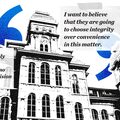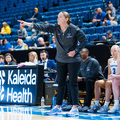Anti-Asian Hate Crime exhibit showcases roots of systemic discrimination

On Monday, the Asian American and Pacific Islander Heritage Month planning committee hosted an Anti-Asian Hate Crime exhibit in Syracuse University’s Schine Student Center. The event explored historical acts of discrimination against Asian Americans like the 1997 ‘Denny’s Incident’ and the Chinese Exclusion Act of 1882. Zabdyl Koffa | Contributing Photographer
Get the latest Syracuse news delivered right to your inbox.
Subscribe to our newsletter here.
In 1997, a group of 10 SU students — six Asian and Asian American students, three Black students and one white student — were denied seating at a local Denny’s. Later that evening, the students left the parking lot with concussions, cuts and bruises.
Almost 30 years later, the Asian American Pacific Islander Heritage Month committee hosted its annual exhibit in the Schine Student Center to remember the encounter, now known as the “Denny’s incident.”
Hosted as part of a series of workshops and events in honor of AAPI Heritage Month, the exhibit framed a podium with carefully crafted poster boards to highlight the incident’s aftermath. The exhibit has taken place over many years, and the collages are contributions of past co-chairs.
“The purpose of the exhibit was to look back at the roots of what systemic oppression is,” said Ellany Tsin, a committee co-chair of the event. “(The posters) look like broken glass because it’s a broken system.”
The poster boards included a variety of news clips and blog posts referencing the incident. Some expanded the scope to other instances of anti-Asian hate, including racist caricatures of Japanese people during World War Two.
A poster-sized version of a 2011 letter to the Syracuse community from five students described the purpose of the exhibit. The exhibit was intended to educate the community about the context of anti-Asian hate crimes, the students wrote, emphasizing “the Syracuse community is not immune.”
The group of students felt that white patrons were being seated preferentially as they waited for over 30 minutes, according to a lawsuit filed at the time. The lawsuit alleged the students were denied service based on race, ethnicity or national origin.
After a student confronted a Denny’s employee, the group was asked to leave by two sheriff’s deputies working as security guards, according to follow-up reporting by The Daily Orange’s in 2007. In the parking lot, some of the students engaged in a physical confrontation with the guards, who were joined by 10 white men who came out of the restaurant, The D.O. reported.
The 10 men beat and verbally assaulted the Asian and Asian American students with slurs, and two Black students left the waiting area of the Denny’s to break up the fight. When the Black students returned to the restaurant, they were also asked to leave, The D.O. reported. Two Denny’s employees involved in the incident were fired, as well as the two security guards.
The students were left with concussions, cuts and bruises, according to reporting by The D.O. The controversy that followed gripped the Syracuse community for years as the students attempted to pursue legal action. The ensuing investigation was eventually dismissed, as the county district attorney found the students could not sufficiently prove their civil rights had been violated. No arrests were made.
William J. Fitzpatrick — the Onondaga County District Attorney at the time, who is still in the position — accused the students of orchestrating the event, according to The D.O. Fitzpatrick said the denial of service and brawl weren’t racially motivated, because slurs were only uttered during the fighting and not before, The D.O. reported.
When the DA’s office dismissed the case after a five-month investigation, SU students were enraged. Days after the decision was announced, around 100 students protested at the Schine Student Center. Half took their grievances to Fitzpatrick’s office, accusing him of bias and corruption, The D.O. reported.
In 2002, a friend of the Asian students involved in the Denny’s incident hosted a workshop at SU titled “The ‘Denny’s Incident’ and Other Hate Crimes,” attended by 45 students. The workshop criticized the lack of support for the students involved, focusing on the broader ignorance of racism against Asian Americans.
The exhibit reminded the campus community of the incident and its significance as time has gone by. However, just 15 students attended its opening.
“I feel like having more people here really would have had (the exhibit) hit home,” Tsin said.
Jasmine Kim, an SU graduate from the class of 2019, created “April 11, 1997,” the short film shown annually at the event. The film presented the incident through the perspective of a victim’s close friend.
The friend explained that bias was present from the moment the students arrived at the hospital, as police used racially charged language when describing the students over police scanners. The film emphasized how isolating the incident felt for Asian and Asian American SU students.
Though the Anti-Asian Hate Crime exhibit reuses much of the same material annually, this year’s installation featured three new posters reflecting this year’s AAPI Heritage Month theme, Mosaic of Memories.
Tsin, who designed the posters, said she used the motif of broken glass shards to symbolize a broken system or an incomplete picture. She designed the posters in a series of three, representing the roots of discrimination, words used to perpetuate hate and the effects of hate.
Among the sharp shapes of the third poster were pictures and words depicting examples of moments of anti-Asian hate in history, like the Chinese Exclusion Act of 1882. The second poster represented the experience of Asian Americans as “forever foreigners.” This references Asian Americans not being truly recognized or understood; even the word “Asian” overgeneralizes the nuanced cultures of an entire continent, Tsin said.
“They were designed to represent the different fragments of the Asian American experience, both the good and the bad and how that shapes our Asian identities,” Zhou Benson, a member of the AAPI Heritage Month planning committee, said.
Tsin is a member of the Syracuse chapter of Sigma Psi Zeta, an Asian-interest sorority and fraternity, as were a majority of the students in attendance. However, despite the organization’s focus on Asian and Asian American issues and culture, member Kiara Reyes was unaware of the Denny’s incident before Monday. As a sophomore, Reyes found it surprising this was her first time hearing about the incident.
“I could really feel the emotions through the video as I was watching (the short film),” Reyes said. “I’m surprised we only speak about it this month instead of the whole year.”
A lack of awareness about hate crimes towards Asians is a wider pattern, Tsin said. When people think of anti-Asian hate, Tsin said they often default to the discrimination the Asian and Asian American community experienced during COVID-19, disregarding other issues. The lack of attendance at AAPI heritage month events reflects this ignorance, Tsin said.

Cole Ross | Digital Design Director
She said another factor contributing to the erasure of anti-Asian hate crimes is the “model minority” stereotype. Some people may view Asians as generally more educated or more “white-adjacent” than other minorities, leading them to believe Asian people don’t face oppression or challenges, Tsin said.
“We’re never truly Asian, we’re never truly American, we’re never truly anything,” Tsin said.
Though the event didn’t attract a large number of students, Benson felt that it was still successful in spreading awareness to those who were there.
Benson’s experience organizing the event was rewarding because she said it helps her to stay close to her Asian roots, a goal she had set coming into college. For Benson, the month’s theme had a personal significance, reflecting the complexity of her identity as an Asian American.
“We have multiple aspects that make us who we are, not just as Asians, but just as people,” she said. “The fragments and pieces coming all together are what a mosaic is.”






